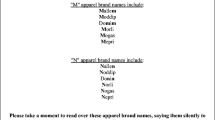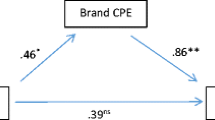Abstract
Sound symbolism research provides considerable support for the relationship between sound and meaning. What is not well understood is how best to imbed sound symbolism to create meaningful brand names. This research investigates three basic decisions or issues that marketers face when embedding sound symbolism in brand names—i.e., (a) where to position the imbed, (b) what type of imbed to use, and (c) what is the effect of combining imbeds. Results of study 1 indicate that imbeds placed after the first syllable of a brand name communicate branding meaning. Also, brand meaning is better conveyed by vowels than consonants in a brand name. Combining consistent vowel and consonant imbeds in a brand name provides an additive effect with respect to communicating brand meaning. Results of study 2 show that combining consistent imbeds in a brand name can have a favorable impact on product choice.
Similar content being viewed by others
Notes
The authors test what they term hard consonants (i.e., k and hard g) vs soft consonants (i.e., f and s).
References
Alter, A. L., & Oppenheimer, D. M. (2006). Predicting short-term stock fluctuations by using processing fluency. Proceedings of the National Academy of Sciences, 103, 9369–9372.
Alter, A. L., & Oppenheimer, D. M. (2009). Uniting the tribes of fluency to form a metagcognitive nation. Personality and Social Psychology Review, 13(3), 219–235.
Anonymous. (2006). Finding the ‘S’ appeal. Frozen Food Age. May (54), 29.
Begley, S. (2002). StrawBerry is no BlackBerry: Building brands using sound. The Wall Street Journal, 26 (August): B1.
Cole, R., Yan, Y., Mak, B., Fanty, M., & Bailey, T. (1996). The contribution of consonants versus vowels to word recognition in fluent speech” Proceedings of the International Conference on Acoustics, Speech, and Signal Processing ICASSP’96 (pp. 853–856). GA: Atlanta.
Collins, L. (1977). A name to conjure with: A discussion of the naming of new brands. European Journal of Marketing, 11(5), 337–363.
Coulter, K. S., & Coulter, R. A. (2010). Small sounds, big deals: Phonetic symbolism effects in pricing. Journal of Consumer Research, 37, 315–328.
Erlich, J. (1995). Giving drugs a good Name. The New York Times Magazine, September, 3, 36–37.
French, P. (1977). Toward an explanation of phonetic symbolism. Word, 28(3), 305–322.
Gupta, P., Lipinski, J., Abbs, B., & Lin, P. (2005). Serial position effects in nonword repetition. Journal of Memory and Language, 53, 141–162.
Heath, T. B., Chatterjee, S., & France, K. R. (1990). Using the phonemes of brand names to symbolize brand attributes. In W. Bearden & A. Parasuraman (Eds.), The AMA educators’ proceedings: Enhancing knowledge development in marketing (pp. 38–42). Chicago, IL: American Marketing Association.
Hinton, L., Nichols, J., & Ohala, J. L. (1994). Introduction: Sound-symbolic processes. In J. L. Ohala, L. Hilton, & J. Nichols (Eds.), Sound symbolism (pp. 1–11). Cambridge, England: Cambridge University Press.
Jespersen, O. (1922). Language: Its nature, development and origin. Longdon, UK: Allen and Unwin.
Keller, K. L., Heckler, S. E., & Houston, M. J. (1998). The effects of brand name suggestiveness on advertising recall. Journal of Marketing, 62, 48–57.
Kewley-Port, D., Burkle, T. Z., & Lee, J. H. (2007). Contribution of consonant versus vowel information to sentence intelligibility for young normal-hearing and elderly hearing-impaired listeners. Journal of the Acoustical Society of America, 122, 2365–2375.
Klink, R. R. (2000). Creating brand names with meaning: The use of sound symbolism. Marketing Letters, 11(1), 5–20.
Klink, R. R. (2001). Creating meaningful new brand names: A study of semantics and sound symbolism. Journal of Marketing Theory and Practice, 9(2), 27–34.
Klink, R. R. (2003). Creating meaningful brands: The relationship between brand name and brand mark. Marketing Letters, 14(3), 143–157.
Klink, R. R. (2009). Gender differences in new brand response. Marketing Letters, 20(3), 313–326.
Klink, R. R., & Athaide, G. A. (2012). Creating brand personality with brand names. Marketing Letters, 23(1), 109–117.
Kotler, P., & Armstrong, G. (2012). Principles of Marketing (14th ed.). Upper Saddle River, New Jersey: Prentice Hall.
Krulich, R. (2011). Vowels control your brain. National Public Radio Blog. December 8. http://www.npr.org/blogs/krulwich/2011/12/07/143265882/vowels-control-your-brain.
Lowrey, T. M., & Shrum, L. J. (2007). Phonetic symbolism and brand name preference. Journal of Consumer Research, 34, 406–414.
MacKay, I. R. (1978). Introducing practical phonetics. Boston, MA: Little, Brown and Co., Inc.
Park, C. W., & Zaltman, G. (1987). Marketing Management. Chicago: The Dryden Press, Inc.
Park, C. W., Jaworski, B. J., & MacInnis, D. (1986). Strategic brand concept-image management. Journal of Marketing, 50(3), 135–145.
Pavia, T., & Costa, J. A. (1993). The winning number: Consumer perceptions of alpha-numeric brand names. Journal of Marketing, 57(July), 85–98.
Robertson, K. R. (1989). Strategically desirable brand name characteristics. Journal of Consumer Marketing, 6(4), 61–71.
Sapir, E. (1929). A study in phonetic symbolism. Journal of Experimental Psychology, 12(3), 225–239.
Schwarz, N. (2004). Metacognitive experiences in consumer judgment and decision making. Journal of Consumer Psychology, 14(4), 332–348.
Shah, A. K., & Oppenheimer, D. M. (2007). Easy does it: The role of fluency in cue weighting. Judgment and Decision Making, 2, 371–379.
Spence, C. (2012). Managing sensory expectations concerning products and brands: Capitalizing on the potential of sound and shape symbolism. Journal of Consumer Psychology, 22(1), 37–54.
Taylor, I. K. (1963). Phonetic symbolism re-examined. Psychological Bulletin, 60(2), 200–209.
Ultan, R. (1978). Size-sound symbolism. In J. H. Greenberg (Ed.), Universals of human language (Phonology, Vol. 2, pp. 525–528). Stanford, CA: Stanford University Press.
Yorkston, E., & Menon, G. (2004). A sound idea: Phonetic effect of brand names on consumer judgments. Journal of Consumer Research, 31(1), 43–51.
Author information
Authors and Affiliations
Corresponding author
Additional information
Richard R. Klink and Lan Wu contributed equally to this work.
Rights and permissions
About this article
Cite this article
Klink, R.R., Wu, L. The role of position, type, and combination of sound symbolism imbeds in brand names. Mark Lett 25, 13–24 (2014). https://doi.org/10.1007/s11002-013-9236-3
Published:
Issue Date:
DOI: https://doi.org/10.1007/s11002-013-9236-3




